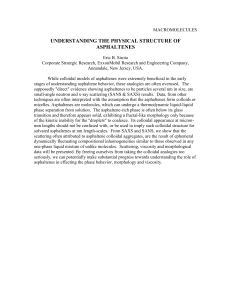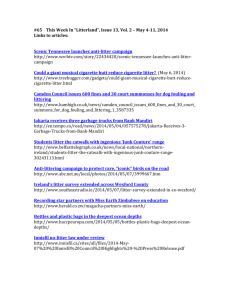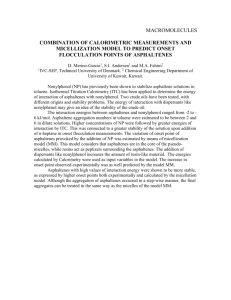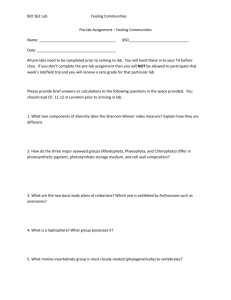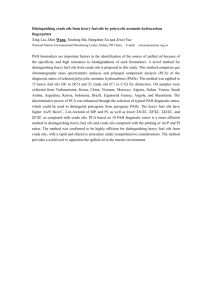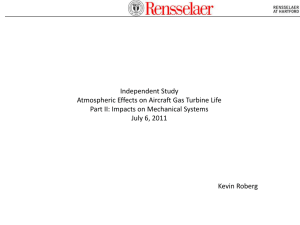Fouling of Nearly Incompatible Oils
advertisement
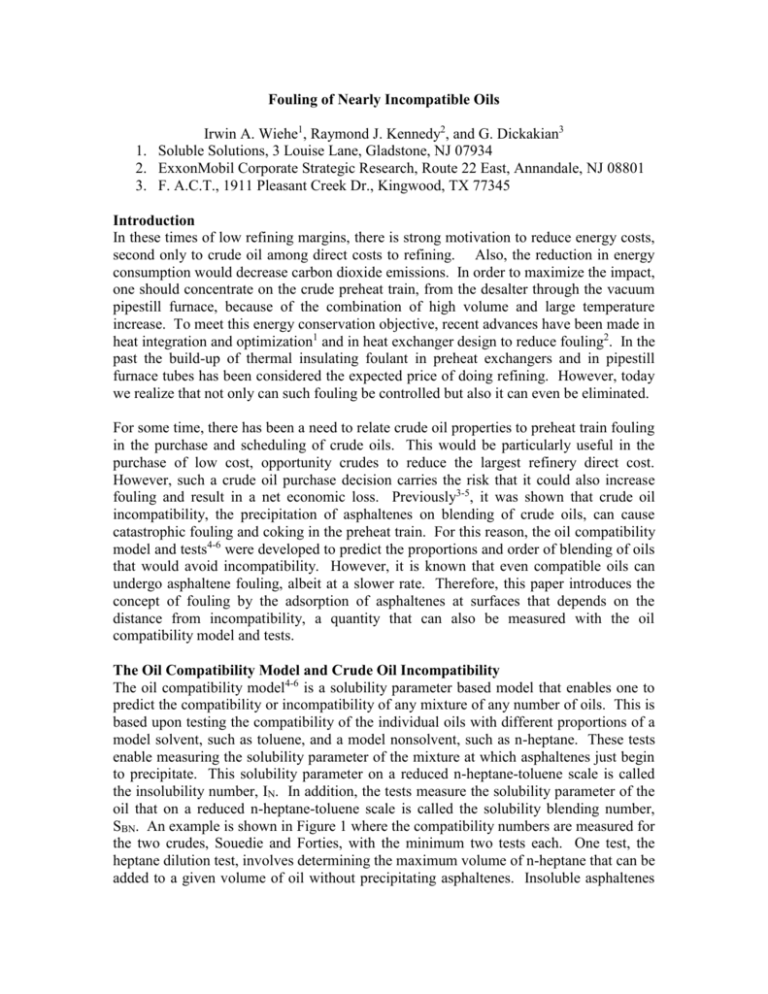
Fouling of Nearly Incompatible Oils Irwin A. Wiehe1, Raymond J. Kennedy2, and G. Dickakian3 1. Soluble Solutions, 3 Louise Lane, Gladstone, NJ 07934 2. ExxonMobil Corporate Strategic Research, Route 22 East, Annandale, NJ 08801 3. F. A.C.T., 1911 Pleasant Creek Dr., Kingwood, TX 77345 Introduction In these times of low refining margins, there is strong motivation to reduce energy costs, second only to crude oil among direct costs to refining. Also, the reduction in energy consumption would decrease carbon dioxide emissions. In order to maximize the impact, one should concentrate on the crude preheat train, from the desalter through the vacuum pipestill furnace, because of the combination of high volume and large temperature increase. To meet this energy conservation objective, recent advances have been made in heat integration and optimization1 and in heat exchanger design to reduce fouling2. In the past the build-up of thermal insulating foulant in preheat exchangers and in pipestill furnace tubes has been considered the expected price of doing refining. However, today we realize that not only can such fouling be controlled but also it can even be eliminated. For some time, there has been a need to relate crude oil properties to preheat train fouling in the purchase and scheduling of crude oils. This would be particularly useful in the purchase of low cost, opportunity crudes to reduce the largest refinery direct cost. However, such a crude oil purchase decision carries the risk that it could also increase fouling and result in a net economic loss. Previously3-5, it was shown that crude oil incompatibility, the precipitation of asphaltenes on blending of crude oils, can cause catastrophic fouling and coking in the preheat train. For this reason, the oil compatibility model and tests4-6 were developed to predict the proportions and order of blending of oils that would avoid incompatibility. However, it is known that even compatible oils can undergo asphaltene fouling, albeit at a slower rate. Therefore, this paper introduces the concept of fouling by the adsorption of asphaltenes at surfaces that depends on the distance from incompatibility, a quantity that can also be measured with the oil compatibility model and tests. The Oil Compatibility Model and Crude Oil Incompatibility The oil compatibility model4-6 is a solubility parameter based model that enables one to predict the compatibility or incompatibility of any mixture of any number of oils. This is based upon testing the compatibility of the individual oils with different proportions of a model solvent, such as toluene, and a model nonsolvent, such as n-heptane. These tests enable measuring the solubility parameter of the mixture at which asphaltenes just begin to precipitate. This solubility parameter on a reduced n-heptane-toluene scale is called the insolubility number, IN. In addition, the tests measure the solubility parameter of the oil that on a reduced n-heptane-toluene scale is called the solubility blending number, SBN. An example is shown in Figure 1 where the compatibility numbers are measured for the two crudes, Souedie and Forties, with the minimum two tests each. One test, the heptane dilution test, involves determining the maximum volume of n-heptane that can be added to a given volume of oil without precipitating asphaltenes. Insoluble asphaltenes are most accurately detected by observing a drop of the mixture between a glass slide and a cover slip under an optical microscope at 100 to 200X. Insoluble asphaltenes are observed throughout the entire view as yellow to brown curved chain agglomerates. In the other test, the toluene equivalence test, the minimum percent toluene in mixture with n-heptane to dissolve asphaltenes is determined at a concentration of one gram of oil and 5 ml. of toluene-n-heptane mixture (test liquid). As shown in Figure 1, the volume percent toluene in the test liquid is plotted versus 100 times the volume ratio of oil to test liquid. The insolubility number is the y-axis intercept of a line drawn through the two points. The solubility blending number is calculated by the equation given in Figure 1. Figure 1. Determination of IN, insolubility number, and SBN, solubility blending number, for Forties and Souedie crude oils Once these compatibility numbers are measured for the oil components, the criteria for compatibility of any blend is that the volume average solubility blending number is greater than the insolubility number of any component in the blend. Since the solubility blending number of Forties, 27, is less than the insolubility number of Souedie, 39, some proportions of these two crude oils are incompatible. The calculation of the solubility blending number of blends of the two crude oils is shown in Figure 2. If one started with a tank containing Souedie crude oil and added Forties, the solubility blending number would drop until reaching 67% Forties. Thereafter, any additional Forties would precipitate asphaltenes and cause catastrophic fouling. However, if one started with a tank containing Forties and added Souedie, the first drop of Souedie would precipitate asphaltenes and this would continue on adding more Souedie. When greater than 33% Souedie is added, no additional asphaltenes would precipitate. However, since asphaltenes in crude oil are a hybrid of a colloidal dispersion and a solution, the rate of dissolution is very slow, of the order of days. Meanwhile, insoluble asphaltenes can cause fouling and coking in a refinery that processes oil in the order of minutes. These very two crude oils were discovered to coke up a refinery vacuum furnace in hours when they were blended in the right proportions but the wrong order. Blends of Souedie and Forties 100 90 80 70 60 50 40 30 20 10 0 0 Forties: SBN = 27, IN = 11 Incompatible Blends Souedie: SBN = 63, IN = 39 IN = 39 for Souedie SBN < IN 10 20 30 40 50 60 70 80 90 Volume % Forties Figure 2. Blends are compatible when the volumetric average solubility blending number is greater than the insolubility number of any component oil. Nearly Incompatible Oils The ratio of the solubility blending number of a mixture of oils to the maximum insolubility number in the mixture is a measure of the distance from incompatibility. When this ratio is less than one, incompatibility is predicted. A value slightly greater than one predicts compatibility but nearly incompatible and a value much greater than one is very compatible. When one considers the adsorption of asphaltenes on a metal surface of process equipment, like a heat exchanger, it makes sense that the more soluble the asphaltenes are in the oil, the less tendency the asphaltenes will have to adsorb at a surface. To test this concept, the fouling by Souedie and Forties crude oils were measured as well as several blends. These tests were conducted by F.A.C.T. using a Thermal Fouling/Coking Test Unit as diagramed in Figure 3. Oil, at room temperature and under 700 psig. nitrogen pressure to prevent boiling, was pumped at 3 ml./min. through an annulus in which a carbon steel rod in the center was heated at a constant 100 Figure 3. Schematic diagram of the Thermal Fouling / Coking Test Unit temperature of 760F. As foulant built up on the rod surface, the insulating effect of the foulant reduced the ability to heat the flowing oil and caused the temperature at the outlet of the annulus to decrease. Therefore, the decrease in temperature of the flowing oil at the annulus over a 3 hour period is a measure of the fouling rate of the oil. The variation in this fouling rate with volume percent Forties crude in blends with Souedie crude is shown in Figure 4. The fouling rate at 25% Forties is only slightly higher than expected from a line drawn through the points at 0% Forties (only Souedie) and 100% Forties. Since at 75% Forties the blend is incompatible, it is not surprising that the fouling rate is the highest measured for this set. The surprise is that the rate of fouling at 50% Forties is higher than the rate of fouling of either pure component of this blend even though this blend is compatible. Based upon this limited data, blending oils such that the solubility blending number of the mixture is greater than 1.3 times the maximum insolubility number assures that the fouling rate is not greater than the fouling rate of either of the pure components. On the other hand, by maintaining the solubility blending number of the mixture to be greater than 1.4 times the maximum insolubility number keeps the fouling rate within the experimental error of the expected fouling rate. Therefore, nearly incompatible oils are in the range of SBN/IN between 1.0 and 1.4 but especially between 1.0 and 1.3. A process for blending petroleum oils to avoid fouling by such nearly incompatible oils is the subject of a recent patent7. SBN / IN = 1.4 SBN / IN = 1.3 SBN / IN = 1.0 Figure 4. Thermal fouling data on Forties – Souedie blends show incompatible blends foul more but nearly incompatible blends also are high fouling. Conclusions This paper demonstrates that fouling of metal surfaces by asphaltenes does not require the asphaltenes to be insoluble. Instead, the asphaltenes can adsorb on the surface from compatible oils, especially if the asphaltenes are in the region of nearly incompatible as measured by the ratio of the solubility blending number to the insolubility number being between 1.0 and 1.4. Since the data that supports this is based upon small laboratory tests, larger laboratory and commercial tests are encouraged. References 1. G. Sipos, J. Lichtscheidl, G. Warecka, B. Kogl, F. Lestak, and H. Simons, ”Effective Heat Integration for Crude Unit Revamp” in Proceedings of First International Conference on Refining Processing, ed. by I. A. Wiehe, AIChE, New York, pp. 295 - 301 (1998). 2. G. T. Polley, D. I. Wilson, and S. J. Pugh, “Designing Crude Oil Pre-Heat Trains with Fouling Mitigation” in Proceedings of 3rd International Conference on Refining Processing, ed. by G. P. Towler, AIChE, New York, pp. 519-523 (2000). 3. G. Dickakian, U.S. patent 4,853,337, assigned to Exxon (1989). 4. I. A. Wiehe, “The Oil Compatibility Model and Crude Oil Incompatibility” in Proceedings of the First International Conference on Petroleum Phase Behavior and Fouling, ed. by I. A. Wiehe, AIChE, New York, pp. 82-87 (1999). 5. I. A. Wiehe and R. J. Kennedy, “The Oil Compatibility Model and Crude Oil Incompatibility”, Energy & Fuels, 14, 56-59 (2000). 6. I. A. Wiehe and R. J. Kennedy, U.S. Patent 5,871,634, , assigned to Exxon (1999). 7. I. A. Wiehe and R. J. Kennedy, U.S. Patent 5,997,723 , assigned to Exxon (1999).
